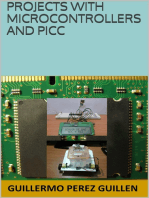Writing Code For Microcontrollers: A Rough Outline For Your Program
Uploaded by
Sritam Kumar DashWriting Code For Microcontrollers: A Rough Outline For Your Program
Uploaded by
Sritam Kumar DashWriting Code for Microcontrollers
A rough outline for your program
The first few lines are comments that describe the file, its purpose, author, etc...
//file : mylab2.c //author : R. Traylor //date : 7.28.05 //modified : 7.29.05 //This code implements lab 2 for ECE473, fall 2005
Also included at the beginning is how the hardware is to be connected. Embedded code is intimately connected to the hardware. If you dont specification hardware connections, the code cannot be debugged efficiently.
// // // // // // // // // // // // HARDWARE SETUP: PORTA is connected to the shared segments of the LED display. PORTA.0 corresponds to seg a, PORTA.1 corresponds to seg b, etc. PORTB bits 4-7 correspond to LED digits 0-3. Switch 0: toggle function, amount to increment or decrement count. Switch 1: toggle function, selects which encoder (0,1) changes count. Switch 2: toggle function, sets display to bright or dim. Enocder pinout: encoder 0, A = PORTE.3 B = PORTE.2 encoder 1, A = PORTE.5 B = PORTE.4
Writing Code for Microcontrollers
A rough outline for your program
Next are the #include files. -These tell the compiler where to look for code you are using but did not include in this file. -Before compilation, the compiler includes the necessary header files to be compiled with the *.c file. Its is as if the header files were copied into the *.c file.
#include <avr/io.h> #include <avr/delay.h> #include lcd.h //holds function prototypes for lcd.c
A good practice to use function prototypes. These are a declaration of the function that omits the function body but only specifies the function's name, argument types and return type. Declaring them all in a header file and including that file allows you to use them in any order without the compiler complaining.
Writing Code for Microcontrollers
A rough outline for your program
Then come the #defines. -These are also called macros. Before compilation the argument of the #define is substituted everywhere the name is used. Its good practice to use all uppercase for #defines.
#define #define #define #define F_CPU 16000000 DELAY_COUNT 4000 TRUE 0x01 FALSE 0x00 // // // // CPU speed in hertz CPU speed div by 4000 logical TRUE logical FALSE
#define MIN(A,B) #define MAX(A,B)
(((A)<(B)) ? (A) : (B) ) (((A)>(B)) ? (A) : (B) )
Writing Code for Microcontrollers
A rough outline for your program
Next is the main section of code. You always have this. -Just inside main() I do register setup, any initalization code such as spi_init() or lcd_init() and give some idea of the program flow. -Note: while(1){ ...... typical in embedded applications.
int main() { DDRA = 0xFF; DDRB = 0xF0; DDRD = 0x00; DDRE = 0x00; PORTE= 0xFF; PORTB= 0x00; PORTA= 0x00; //set //set //set //set //set //set //set port port port port port port port A to bits D to E to E to B to A to all 4-7 all all all all all outputs B as outputs inputs inputs pullups zeros zeros
//main while loop of program follows // -checks encoders // -increment/decrement count if something changed // -display next digit // -check increment/decrement amount and encoder to check while(1){ _delay_loop_2(500); //loop debounce required
Writing Code for Microcontrollers
A rough outline for your program
Next are function calls or procedures. -For each function or procedure, clearly define how it operates.
/************************************************************************/ // bound_count // Keeps the count from going below zero and above 999. // Takes a 16 bit unsigned int and returns the same. /************************************************************************/ int16_t bound_count(int16_t in_value) { if(in_value < 0) return 0; if(in_value > 999) return 999; return in_value; } //bound_count
Writing Code for Microcontrollers
A rough outline for your program
Clear commenting cannot be stressed enough! For example.....
/*************************************************************************/ // encoder_chk // Takes an argument (either 0 or 1)of the encoder to check. If the // encoder is moved, the function returns: // 1 if CW rotation detected, // 0 if CCW rotation detected // -1 if no movement detected. // Note: the return value is a _signed_ 8-bit int. // Expected pinout: // encoder 0, A output = PORTE.3 // B output = PORTE.2 // encoder 1, A output = PORTE.5 // B output = PORTE.4 // Port E is expected to be pulled up. Encoder causes switch // closure to ground through a 1K resistor. // Debounce time is 12 times each ISR run or loop time. // Code was adapted from Ganssel's "Guide to Debouncing" /*************************************************************************/
Note comment style. Dont box areas with /* */. Causes too much re-editing.
Writing Code for Microcontrollers
Programming on-board peripherals
When programming control registers for on-board peripherals, use the most appropriate form to maintain readability and portability. For instance:
To set this register up, this would be most clear: TCCRO = (1<<FOC0) | (1<<WGM00) | (1<<CS00); TCCRO would be loaded with 0b1100_0001; This form is most likely to work across multiple models of the AVR architecture.
Writing Code for Microcontrollers
Programming on-board peripherals
On the other hand, some control registers are best setup with a hex value. For instance:
To set this register up, this would be most clear: OCR0 = 0x53; // OCR0 match is at 0x53
Writing Code for Microcontrollers
Programming on-board peripherals
Remember that to only set or reset certain bits, use the |= or &= format. This cannot be stressed enough. Ignore this at your own peril. For example, to clear the output compare flag zero (OCF0) interrupt for counter timer 0 for we need to write a one to bit one of the TIFR register and not touch bit zero.
If we simply wrote a 0x02 to TIFR, a pending interrupt in the TOV0 bit would be cleared and lost. So instead we do this: TIFR |= (1<<OCF0); // clear OCF0 interrupt and not this: TIFR = (1<<OCF0); //clear OCFO interrupt(OOPS!)
Writing Code for Microcontrollers
Programming on-board peripherals
By using the predefined names in io.h, code is kept portable. For example:
// from code for a mega48 void spi_init(void){ DDRB |= (1 << PB2) | (1 << PB3) | (1 << PB5); //Turn on SS, MOSI, SCLK SPCR=(1<<SPE) | (1<<MSTR); //enbl SPI, MSB 1st, init clk as low SPSR=(1<<SPI2X); //SPI at 2x speed (0.5 MHz) }//spi_init
//from code for a mega128 void spi_init(void){ DDRB |= (1<<PB2) | (1<<PB1) | (1<<PB0); //Turn on SS, MOSI, SCLK SPCR=(1<<SPE) | (1<<MSTR); //enbl SPI, clk low init, rising edge sample SPSR=(1<<SPI2X); //SPI at 2x speed (8 MHz) }//spi_init
Only the pin definitions for ports differ. Why does this work?
Writing Code for Microcontrollers
Programming on-board peripherals
from iom128.h in (.../avr/avr/include/avr)
/* ATmega128 SPI Control Register */ #define SPCR _SFR_IO8(0x0D) /* SPI Control Register - SPCR */ #define SPIE 7 #define SPE 6 #define DORD 5 #define MSTR 4 #define CPOL 3 #define CPHA 2 #define SPR1 1 #define SPR0 0
from iomx8.h (included from iom48.h) also in (.../avr/avr/include/avr) #define SPCR _SFR_IO8 (0x2C) /* SPCR */ #define SPIE 7 #define SPE 6 #define DORD 5 #define MSTR 4 #define CPOL 3 #define CPHA 2 #define SPR1 1 #define SPR0 0
Although the SPCR register is at a different address and the control register bits may have been at different positions, as long as these definitions are here, the code is portable across any Mega type processor.
Writing Code for Microcontrollers
Other Programming Perls
Comment as you code; not as a separate activity. Keep comments with the code they document. Update the comments with the code. Leave debugging code in the source file. Comment out debugging code but leave it in place. Maybe use #ifdef statements for debug code. Initialize each peripheral unit within its own function call; nowhere else. Avoid cleverness. Make your intentions clear to someone else who may end up reading your code. Put all your #defines in one place. Preferably in an header file.
Writing Code for Microcontrollers
Programming Perls last words
These programs are different than any you have written before. Sloppiness will be rewarded with grief. You will have multiple asynchronous real-time events occurring that you must handle within fixed time frames or its broken. Its not easy to do. When you can't find a bug that you've been working on for an hour or so, print out your code, shut your laptop, and walk away. Go for a short walk to the coffee shop. Go by yourself. Let the right-brain have a go at things. Let go, take a deep breath. You are about to become productive. Get a cup of coffee and read your code. Walk all the way through it. Several times. Red line anything that is even slightly out of sorts. Then go back, edit and recompile. You will be surprised at how many bugs you've found and fixed. All this may take you one hour. I bet you will find its the best spent hour of the day. Too often we get stuck in the frenzied edit, recompile, test loop. You have confused motion with action. Pull out of the the spin. It works.
Writing Code for Microcontrollers
Programming quotations
Programming can be fun, so can cryptography; however, they should not be confused. -Charles Kreitzberg and Ben Shneiderman The sooner you start to code, the longer the program will take. -Roy Carls The most important single aspect of software development is to be clear about what you are trying to build. -Bjarne Stroustrup If the code and comments disagree, both are probably wrong. -Norm Schryer Always code as if the guy who ends up maintaining your code will be a violent psychopath who knows where you live. -Damian Conway Documentation is a love letter that you write to your future self. -Camian Conway
You might also like
- Assembly Programming:Simple, Short, And Straightforward Way Of Learning Assembly LanguageFrom EverandAssembly Programming:Simple, Short, And Straightforward Way Of Learning Assembly Language5/5 (2)
- 100 Embedded C Interview Questions Your Interviewer Might Ask AticleWorld PDF100% (1)100 Embedded C Interview Questions Your Interviewer Might Ask AticleWorld PDF44 pages
- Objective: To Understand The Basic Concept and Functionality of Assembly LanguageNo ratings yetObjective: To Understand The Basic Concept and Functionality of Assembly Language9 pages
- 1964 Recompiling Engine Documentation DocumentationNo ratings yet1964 Recompiling Engine Documentation Documentation16 pages
- An Introduction To Programming For Hackers - Part2100% (1)An Introduction To Programming For Hackers - Part214 pages
- PIC16F87X Tutorial by Example: Document HistoryNo ratings yetPIC16F87X Tutorial by Example: Document History69 pages
- Topic 9 AVR Programming in C (ISMAIL - FKEUTM 2018)No ratings yetTopic 9 AVR Programming in C (ISMAIL - FKEUTM 2018)94 pages
- CECS 347 Programming in C Sylabus: Writing C Code For The 8051No ratings yetCECS 347 Programming in C Sylabus: Writing C Code For The 805152 pages
- Programming The PSoC With 8051 Assembly InstructionsNo ratings yetProgramming The PSoC With 8051 Assembly Instructions6 pages
- AVR Microcontroller Fuse Bits Configuration CreatiNo ratings yetAVR Microcontroller Fuse Bits Configuration Creati9 pages
- Comsats University: Lab # 01 Introduction To Development Tools and Lab SoftwareNo ratings yetComsats University: Lab # 01 Introduction To Development Tools and Lab Software7 pages
- Esc - 1991 - Vol2 - Page710 - Ward - Manipulating Hardware With CNo ratings yetEsc - 1991 - Vol2 - Page710 - Ward - Manipulating Hardware With C6 pages
- How To Write A Simple Bootloader For AVR in C Language100% (3)How To Write A Simple Bootloader For AVR in C Language7 pages
- Ee - 105 - ADSP-2100 Family C Programming Examples Guide (En)No ratings yetEe - 105 - ADSP-2100 Family C Programming Examples Guide (En)61 pages
- Digital Design Lab Manual: Introduction To VerilogNo ratings yetDigital Design Lab Manual: Introduction To Verilog48 pages
- Lab 2 - Part 3 Assembly Language Programming and 9S12 PortsNo ratings yetLab 2 - Part 3 Assembly Language Programming and 9S12 Ports5 pages
- C Programming for the Pc the Mac and the Arduino Microcontroller SystemFrom EverandC Programming for the Pc the Mac and the Arduino Microcontroller SystemNo ratings yet
- CISCO PACKET TRACER LABS: Best practice of configuring or troubleshooting NetworkFrom EverandCISCO PACKET TRACER LABS: Best practice of configuring or troubleshooting NetworkNo ratings yet
- Assembly Programming:Simple, Short, And Straightforward Way Of Learning Assembly LanguageFrom EverandAssembly Programming:Simple, Short, And Straightforward Way Of Learning Assembly Language
- 100 Embedded C Interview Questions Your Interviewer Might Ask AticleWorld PDF100 Embedded C Interview Questions Your Interviewer Might Ask AticleWorld PDF
- Objective: To Understand The Basic Concept and Functionality of Assembly LanguageObjective: To Understand The Basic Concept and Functionality of Assembly Language
- 1964 Recompiling Engine Documentation Documentation1964 Recompiling Engine Documentation Documentation
- An Introduction To Programming For Hackers - Part2An Introduction To Programming For Hackers - Part2
- Topic 9 AVR Programming in C (ISMAIL - FKEUTM 2018)Topic 9 AVR Programming in C (ISMAIL - FKEUTM 2018)
- CECS 347 Programming in C Sylabus: Writing C Code For The 8051CECS 347 Programming in C Sylabus: Writing C Code For The 8051
- Programming The PSoC With 8051 Assembly InstructionsProgramming The PSoC With 8051 Assembly Instructions
- AVR Microcontroller Fuse Bits Configuration CreatiAVR Microcontroller Fuse Bits Configuration Creati
- Comsats University: Lab # 01 Introduction To Development Tools and Lab SoftwareComsats University: Lab # 01 Introduction To Development Tools and Lab Software
- Esc - 1991 - Vol2 - Page710 - Ward - Manipulating Hardware With CEsc - 1991 - Vol2 - Page710 - Ward - Manipulating Hardware With C
- How To Write A Simple Bootloader For AVR in C LanguageHow To Write A Simple Bootloader For AVR in C Language
- Ee - 105 - ADSP-2100 Family C Programming Examples Guide (En)Ee - 105 - ADSP-2100 Family C Programming Examples Guide (En)
- Digital Design Lab Manual: Introduction To VerilogDigital Design Lab Manual: Introduction To Verilog
- Lab 2 - Part 3 Assembly Language Programming and 9S12 PortsLab 2 - Part 3 Assembly Language Programming and 9S12 Ports
- C Programming for the Pc the Mac and the Arduino Microcontroller SystemFrom EverandC Programming for the Pc the Mac and the Arduino Microcontroller System
- Foundation Course for Advanced Computer StudiesFrom EverandFoundation Course for Advanced Computer Studies
- CISCO PACKET TRACER LABS: Best practice of configuring or troubleshooting NetworkFrom EverandCISCO PACKET TRACER LABS: Best practice of configuring or troubleshooting Network
- Interview Questions for IBM Mainframe DevelopersFrom EverandInterview Questions for IBM Mainframe Developers



























































